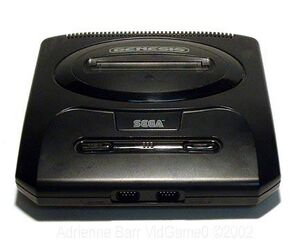|
Sega Genesis
| |
|
Manufacturer
|
|
|
Type
|
Video game console
|
|
Generation
|
Fourth generation
|
|
Release date
|
October 29, 1988
(Japan) August 14, 1989 (North America) November 30, 1990 (Europe) |
|
Discontinued
|
1999
|
|
Units sold
|
Estimated at 40 million
|
|
Media
|
ROM cartridge
|
|
CPU
|
Motorola 68000 and Zilog Z80
|
|
Predecessor
|
|
|
Successor
|
|
The Sega Genesis (or Mega Drive, as it was known in other territories) was a 16-bit home video game console. It had a large library of games and many exclusive franchises. It's main competitors were Nintendo's 8-bit NES and later the 16-bit SNES.
Later in the console's life it gained two add-ons - the Sega CD which allowed the console to play CD games and the Sega 32X which had a library of 32-bit games.
The console came in three models, as well as a handheld version called the Sega Nomad. The Nerd owns all of them.
There were several things that bothered the Nerd in terms of the Sega 32X. One, It's inserterted on top of the Genesis, and he claims that a Model 1 Genesis need metal prongs in its slot before the 32x addon can be inserted. Two, its games aren't end labeled. Three, It has its own power adapter, which is some sort of "box thing" on its plug, which he says take up too much room. Four, it was made shortly before the Sega Saturn. At the end of the video explaining the addon, he burns it.
Accessories[]
In addition to accessories such as the Power Base Converter, the Sega Genesis also supports two add-ons that each support their own game libraries. The first is the Sega CD (known as the Mega-CD in Europe and Japan), a compact disc-based peripheral that can play its own library of games in CD-ROM format. The second is the Sega 32X, a 32-bit peripheral which utilizes ROM cartridges as a format and serves as a pass-through for Genesis games. Both add-ons were officially discontinued in 1996.
Network services[]
In its first foray into online gaming, Sega created Sega Meganet, which debuted in Japan on November 3, 1990. Operating through a cartridge and a peripheral called the "Mega Modem", this system allowed Mega Drive players to play seventeen games online. A North American version of this system, dubbed "Tele-Genesis", was announced but never released. Another phone-based system, the Mega Anser, turned the Japanese Mega Drive into an online banking terminal.
Then, in 1994, Sega started the Sega Channel, a game distribution system utilizing cable television services Time Warner Cable and TCI. Using a special peripheral, Genesis players could download a title from a library of fifty each month, as well as demos for upcoming games. Games were downloaded to the console's internal memory and were deleted when the console was powered off. The Sega Channel reached 250,000 subscribers at its peak and ran until July 31, 1998, well past the release of the Sega Saturn.
In an effort to compete with Sega, third-party developer Catapult Entertainment created the XBAND, a peripheral which allowed Genesis players to engage in online competitive gaming. Utilizing telephone services to share data, XBAND was initially offered in five U.S. cities in November 1994. The following year, the service was extended to the SNES, and Catapult teamed up with Blockbuster Video to market the service, but as interest in the service waned, XBAND was discontinued in April 1997.
Genesis games the Nerd has reviewed[]
- Ghostbusters
- The Addams Family
- Batman: Revenge of the Joker
- Michael Jackson's Moonwalker
- X-Men
- X-Men 2: Clone Wars
- T2: The Arcade Game
- Castlevania: Bloodlines
- Action 52
- Back to the Future Part III
- Jurassic Park
- Jurassic Park: Rampage Edition
- Dark Castle
- Spiritual Warfare
- Exodus: Journey to the Promised Land
- Joshua
- Bible Adventures
- CrazyBus
- Beavis & Butt-Head
- The Berenstain Bears: Camping Adventure
- Mighty Morphin Power Rangers
- Super Hydlide
- Home Alone
- Home Alone 2: Lost in New York
- Mortal Kombat
- Time Killers
- Ecco the Dolphin
- Caesar's Palace
- Pac-Man 2: The New Adventures
- Greendog: The Beached Surfer Dude!
- The Incredible Crash Dummies

